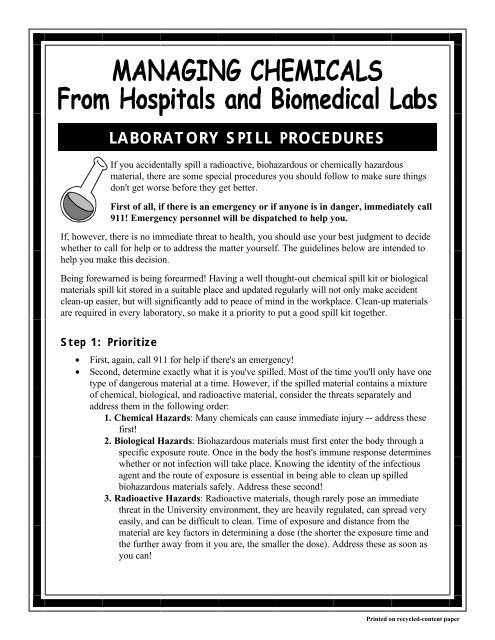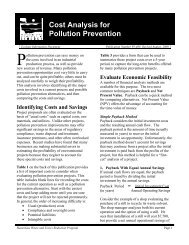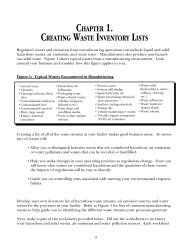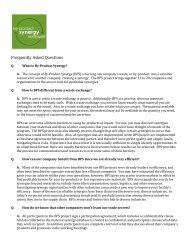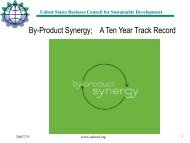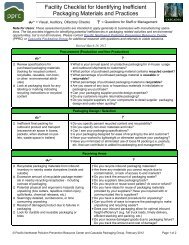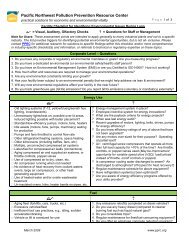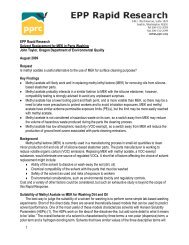Laboratory Spill Procedures Handout
Laboratory Spill Procedures Handout
Laboratory Spill Procedures Handout
You also want an ePaper? Increase the reach of your titles
YUMPU automatically turns print PDFs into web optimized ePapers that Google loves.
LABORATORY SPILL PROCEDURES<br />
If you accidentally spill a radioactive, biohazardous or chemically hazardous<br />
material, there are some special procedures you should follow to make sure things<br />
don't get worse before they get better.<br />
First of all, if there is an emergency or if anyone is in danger, immediately call<br />
911! Emergency personnel will be dispatched to help you.<br />
If, however, there is no immediate threat to health, you should use your best judgment to decide<br />
whether to call for help or to address the matter yourself. The guidelines below are intended to<br />
help you make this decision.<br />
Being forewarned is being forearmed! Having a well thought-out chemical spill kit or biological<br />
materials spill kit stored in a suitable place and updated regularly will not only make accident<br />
clean-up easier, but will significantly add to peace of mind in the workplace. Clean-up materials<br />
are required in every laboratory, so make it a priority to put a good spill kit together.<br />
Step 1: Prioritize<br />
• First, again, call 911 for help if there's an emergency!<br />
• Second, determine exactly what it is you've spilled. Most of the time you'll only have one<br />
type of dangerous material at a time. However, if the spilled material contains a mixture<br />
of chemical, biological, and radioactive material, consider the threats separately and<br />
address them in the following order:<br />
1. Chemical Hazards: Many chemicals can cause immediate injury -- address these<br />
first!<br />
2. Biological Hazards: Biohazardous materials must first enter the body through a<br />
specific exposure route. Once in the body the host's immune response determines<br />
whether or not infection will take place. Knowing the identity of the infectious<br />
agent and the route of exposure is essential in being able to clean up spilled<br />
biohazardous materials safely. Address these second!<br />
3. Radioactive Hazards: Radioactive materials, though rarely pose an immediate<br />
threat in the University environment, they are heavily regulated, can spread very<br />
easily, and can be difficult to clean. Time of exposure and distance from the<br />
material are key factors in determining a dose (the shorter the exposure time and<br />
the further away from it you are, the smaller the dose). Address these as soon as<br />
you can!<br />
1<br />
Printed on recycled-content paper
Step 2: Take the appropriate steps<br />
Once you know what kind of substance you're dealing with, there are special<br />
techniques to use to deal with the spill<br />
Education and Prevention<br />
Chemical <strong>Spill</strong>s<br />
The best way to deal with a chemical spill is to be educated. Your internal training should cover<br />
aspects such as:<br />
• Chemical hazards<br />
• Risk assessment<br />
• Personal protection<br />
• <strong>Spill</strong> clean-up procedures<br />
• Regulatory requirements<br />
Consider getting a proactive audit of your lab safety program and chemical spill readiness by<br />
contacting a governmental or private environmental consultation program. An outside perspective<br />
often helps.<br />
Chemical <strong>Spill</strong> Basics<br />
Hazardous material spills that do not endanger workers in the immediate area may be cleaned up<br />
by area personnel who have been trained and are properly equipped to clean up the spilled material<br />
safely. Hazardous material spills that cannot be safely adsorbed, neutralized, or otherwise<br />
controlled at the time of release by employees in the immediate release area are considered to be<br />
emergencies requiring outside assistance, typically by your local Fire Department , on-site Environmental<br />
Health & Safety (EH&S) staff, and possibly a spill cleanup contractor.<br />
When in doubt about whether you need help or not, it is best to call for help.<br />
Major Chemical <strong>Spill</strong>s<br />
A major chemical spill is:<br />
Pull the Fire Alarm or call 911<br />
•One that has caused injury to personnel or is likely to cause injury, or<br />
•Uncontained and spreading out of the immediate area endangering other labs, or<br />
•Has the potential to cause a fire.<br />
Pull the fire alarm if someone has been injured. This is the fastest way to get help and alert others<br />
nearby of the emergency. The Fire Department is the primary responder for major chemical<br />
spills.<br />
2
If you can answer YES to the following 4 questions, it is safe for you to<br />
clean up the spill:<br />
1. Do you know what chemical was spilled?<br />
2. Do you know the hazards of the spilled chemical?<br />
3. Do you have a chemical spill kit?<br />
4. Can you protect yourself from these hazards?<br />
If you answered NO to any of the above questions or need assistance with the spill cleanup,<br />
evacuate the area and call your EH&S coordinator, your spill response contractor or the fire de-<br />
Chemical <strong>Spill</strong> Kits<br />
All laboratories must have spill clean up materials available. <strong>Spill</strong> kits and replacement parts are<br />
available from many lab safety supply companies. A complete spill kit such as the one listed below<br />
may be purchased for less than $100.<br />
Adsorbent Neutralizing<br />
Materials<br />
5 <strong>Spill</strong> pads,<br />
universal for<br />
acid, base, oil,<br />
solvents<br />
Misc. Containers/Supplies Misc. Protective Gear<br />
I box baking soda 4, 20 x 30”, heavy duty (6mm)<br />
plastic bags<br />
1 five gallon reusable screw top<br />
plastic drum. Good to store all kit<br />
supplies and later used to hold<br />
bagged plastic spill waste for<br />
pickup.<br />
Snap together dust pan and whisk<br />
broom<br />
3<br />
1 goggle, chemical splash<br />
1 pair heavy-duty nitrile<br />
gloves<br />
8 pairs of Microgrip<br />
powder free nitrile gloves,<br />
chemical resistant, in<br />
various sizes, allows for<br />
dexterity.<br />
Respirators may be necessary for spill clean up. The use of respirators requires prior medical<br />
evaluation, training, and fit testing.
Biohazardous <strong>Spill</strong>s<br />
Each lab coordinator should be responsible for developing spill clean-up procedures that are<br />
appropriate for the materials used in the laboratory, as well as assuring that a spill kit is<br />
assembled and placed in a strategic location outside of, but near to, an area where a spill could<br />
occur. Furthermore, anyone working with biological materials must receive training in spill<br />
clean-up appropriate for materials routinely used.<br />
Use the following procedures to deal with a spill of biohazardous materials, either inside a<br />
Biological Safety Cabinet, or outside of one:<br />
Biohazard <strong>Spill</strong>s Outside a Biological Safety Cabinet<br />
• Hold your breath, leave the room immediately, and close the door. One good way to<br />
identify the spill area is to drop your laboratory coat on the area;<br />
• Warn others not to enter the contaminated area;<br />
• Remove contaminated garments and put them into a container for autoclaving.<br />
Thoroughly wash your hands and face and any other exposed areas of the body. If the<br />
spill involves potential exposure of bloodborne pathogens, follow your facility’s<br />
bloodborne pathogen policy for managing and reporting these exposures;<br />
• Wait 30 minutes to allow dissipation of aerosols created by the spill if in a laboratory<br />
where the airflow is negative relative to the surrounding areas. For spills in other areas, it<br />
may be appropriate to begin the clean-up immediately after assembling the needed cleanup<br />
materials;<br />
• Put on a long-sleeve gown, mask, and rubber gloves before re-entering the room. For a<br />
high risk agent, a jumpsuit with tight-fitting wrist seals and use of a respirator should be<br />
considered;<br />
• Pour a decontaminant solution appropriate for the agent involved (e.g. household bleach<br />
is an appropriate decontaminant for human blood and body fluids) around the spill and<br />
allow to flow into the spill. Paper towels soaked with the decontaminant may be used to<br />
cover the area. To minimize aerosolization, avoid pouring the decontaminant solution<br />
directly onto the spill;<br />
• Let stand for 20 minutes to allow an adequate contact time;<br />
• Using an autoclavable dust pan and squeegee, transfer all contaminated materials (paper<br />
towels, glass, liquid, gloves, etc.) into a deep autoclave pan. Cover the pan with<br />
aluminum foil or other suitable cover and autoclave according to standard directions.<br />
Reusable items should be separated from non-autoclavable plastic, as the plastic will melt<br />
and will then be impossible to remove from other items in contact with them.<br />
Biohazard <strong>Spill</strong>s Inside a Biological Safety Cabinet<br />
In order to prevent escape of contaminants from the cabinet and while the cabinet continues to<br />
operate, chemical decontamination procedures are recommended and should be initiated at once.<br />
• Spray or wipe walls, work surfaces, and equipment within the cabinet with a solution of<br />
an appropriate decontaminant for the agent involved. If the gloves being used are not<br />
puncture resistant, additional care is necessary if the spill involves broken glass or other<br />
sharp material;<br />
4
(Biohazardous <strong>Spill</strong>s continued)<br />
• Flood the top work surface tray and, if it is a Class II biological safety cabinet, the drain<br />
pans and catch basins below the work surface with the decontaminant and allow to stand<br />
for 10-15 minutes. The contact time should be extended to 30 minutes for large spills or<br />
spills containing large amounts of proteinaceous material;<br />
Remove excess decontaminant from the tray by wiping with a sponge or cloth soaked in<br />
decontaminant. For Class II biological safety cabinets, drain the tray into the catch basin<br />
below the work surface, lift out the tray and removable front intake grille, and wipe off<br />
top and bottom (underside) surfaces with a sponge or cloth soaked in a decontaminant.<br />
Replace the grille and drain decontaminant from the cabinet base into an appropriate<br />
container and autoclave according to standard procedures. Be sure to place gloves, cloth,<br />
and/or sponge into an autoclave pan to be autoclaved.<br />
*<strong>Spill</strong>s Outside the <strong>Laboratory</strong> (During Transport)<br />
If a biohazardous agent is spilled during transport outside the laboratory, the main difference<br />
from the first procedure is to initiate the cleanup immediately. Otherwise, use those procedures.<br />
Because it would already be too late to prevent aerosolization in this case, it is better to place<br />
extra emphasis on prevention of spills during transport:<br />
• Develop a procedure for the removal of biohazardous materials for incubation,<br />
refrigeration, or for any other reason from the laboratory, and enforce adherence to it;<br />
• Place all such materials in an unbreakable container that would prevent the escape of<br />
liquid or aerosol if it were dropped. One-gallon or half-gallon paint pails are good<br />
examples of acceptable containers;<br />
• Label the container with the biohazard symbol to ensure no mistake is made as to the<br />
contents.<br />
*Information taken from "<strong>Laboratory</strong> Safety, Principals and Practices, Second Edition",<br />
Chapter 14, "Decontamination, Sterilization, Disinfection, and Antisepsis" by Donald Vesley<br />
and James L. Lauer.<br />
Biohazard <strong>Spill</strong> Kit<br />
A well designed spill kit is highly recommended. It can save injury, time, and resources. The<br />
following items would be excellent choices for a Biohazard <strong>Spill</strong> Kit:<br />
• An appropriate chemical decontaminant -- in most cases a 10% household bleach<br />
solution is a good choice, but keep in mind that bleach will corrode stainless steel if left<br />
in contact with it for 30 minutes or more. For human blood and body fluids, iodophors or<br />
70% alcohol is appropriate;<br />
• Materials to absorb liquids after decontamination -- this could include paper towels,<br />
absorbent lab pads, or special materials designed to absorb large volumes of liquid. Keep<br />
in mind the volumes of liquid typically used in the laboratory area when selecting an<br />
absorbent;<br />
• Appropriate personal protective equipment to wear during clean-up -- gloves and a<br />
long-sleeved laboratory coat or gown are always necessary. Facial protection should be<br />
considered for large spills as well as protection against splash and splatter of the chemical<br />
decontaminant. Additional personal protective equipment is necessary when working<br />
with Class 3 agents.<br />
5
(Biohazardous <strong>Spill</strong>s continued)<br />
• A mechanical means for handling broken glass -- this could include tongs, forceps,<br />
small disposable scoops and sponges, autoclavable dust pans, or any other method that<br />
prevents direct contact with the broken glass. Broken glass represents a high cutting<br />
danger and should not be touched directly, especially if it is contaminated with a<br />
biohazardous agent;<br />
• Biohazard bags, sharps containers, and/or other containers to place the material in<br />
for further treatment and disposal.<br />
Mercury <strong>Spill</strong>s<br />
Mercury spills are one of the most common chemical spills. Thermometers, manometers, blood<br />
pressure cuffs, and many other instruments contain elemental mercury and are easily broken.<br />
Fortunately, mercury is simple to clean up and poses little risk to your health unless it is spilled<br />
within heated devices or gets trapped in upholstery, carpeting, or other surfaces where there is<br />
an increased likelihood of human contact.<br />
Health Hazards<br />
• Mercury is an inorganic element that is readily absorbed via the respiratory tract (as in<br />
elemental mercury vapor or mercury compound dust form), gastrointestinal tract, and<br />
skin surface. Fortunately, at room temperature mercury is not very volatile and poses little<br />
risk. If spilled on a heated surface, however, its volatility increases and therefore the<br />
risk of inhalation. Mercury spilled on fabric or carpet is also very difficult to clean and<br />
can also pose an increased risk of inhalation.<br />
• Mercury in the organic form is extremely toxic via skin contact, inhalation, and ingestion.<br />
These compounds target the central nervous system and can lead to brain damage, tremors,<br />
speech impediments, blindness, and death.<br />
• Be mindful of your accessories - jewelry can be ruined by contact with metallic mercury.<br />
Mercury <strong>Spill</strong> Kits and Assistance<br />
There are several different products available that are appropriate for cleaning up mercury spills.<br />
Example Mercury <strong>Spill</strong> Kit<br />
Number Item<br />
3 Large Nitrile Gloves<br />
3 Ziplock Bags 9x13<br />
1 Pkg. Cloth Sponges<br />
3 Syringe Aspirator<br />
1 500 g Hg Absorbent Powder<br />
3 Small Scoop-Scraper<br />
6
(Mercury <strong>Spill</strong>s continued)<br />
How to handle a variety of spill situations<br />
Mercury thermometer spills on smooth surfaces:<br />
1. Isolate the area by marking off the spill section to prevent inadvertent spreading of the<br />
mercury.<br />
2. Wear 2 pairs of chemical resistant gloves (nitrile or silver shield), lab coat, and eye<br />
protection during cleanup operations.<br />
3. Using a scraper, push the scattered mercury droplets together into a larger droplet.<br />
4. Aspirate the larger mercury droplets and place them into a zip lock bag or screw top<br />
container.<br />
5. Sprinkle mercury absorbent powder lightly over the remaining micro-droplets of<br />
mercury.<br />
6. Spray a water mist over the powder.<br />
7. Using the scraper, mix the materials into a paste amalgam. The resulting substance will<br />
not emit dangerous mercury vapors.<br />
8. Scoop up the amalgam and wipe down the surfaces with a scraper and damp sponge.<br />
Place the amalgam, sponge, gloves, scraper, scoop, and all other mercury contaminated<br />
debris into the zip lock bag or container. Tape sharp ends of the glass thermometer and<br />
place it into the bag or container as well.<br />
9. Label the bag or container with a hazardous waste label.<br />
Mercury manometer spills on any surface and mercury spills on porous surfaces (carpet,<br />
upholstery, concrete, etc.):<br />
The preferred method to clean up large mercury spills on any surface or any size<br />
mercury spill on porous flooring or carpeting is the use of a mercury vacuum. In some<br />
instances the surface cannot be cleaned or decontaminated. Carpets and fabrics are<br />
typically disposed of as hazardous waste. Post clean-up monitoring should also be<br />
conducted.<br />
Mercury spills in ovens, incubators, hot water baths or other elevated temperature<br />
situations:<br />
When the spill occurs in equipment with elevated temperature conditions such as an<br />
oven or incubator, an exposure to mercury vapor is more likely.<br />
• Shut off the equipment and leave the area immediately.<br />
• The cleanup should be performed after the device has cooled.<br />
• Mercury vapor monitoring must be performed prior to any cleanup.<br />
• Continued mercury vapor monitoring will need to be conducted after the cleanup is<br />
complete.<br />
Large mercury spills:<br />
A broken manometer or other large mercury spill will require use of a mercury vacuum<br />
and mercury monitoring. Monitoring should be part of the evacuation process and care<br />
should be taken to help isolate the spill area and prevent spreading. Post clean-up<br />
monitoring should also be conducted.<br />
7
Radioactive Materials <strong>Spill</strong>s<br />
<strong>Spill</strong>s of radioactive materials are classified into two categories, Major <strong>Spill</strong>s and Minor <strong>Spill</strong>s,<br />
based on the amount of material spilled.<br />
1. Consult the nuclide chart below and determine which Group the spilled radionuclide belongs<br />
to.<br />
2. Estimate the amount of radioactivity, in millicuries, that has been spilled.<br />
Look at the criteria for Major <strong>Spill</strong>s and Minor <strong>Spill</strong>s below to decide which set of procedures<br />
you should follow.<br />
Group 1<br />
ALI > 10 mCi<br />
H-3<br />
F-18<br />
Cr-51<br />
Cu-64m<br />
Tc-99m<br />
In-113m<br />
Major <strong>Spill</strong>s<br />
Group 2<br />
Group 3<br />
1 mCi < ALI < 10 mCi 0.1 mCi < ALI < 1 mCi<br />
C-14 Mn-54 Mo-99 Na-22 Sr-89<br />
Na-24 Fe-55 In-111 P-32 Cd-109<br />
P-33 Co-57 I-123 Cl-36 Ag-110m<br />
S-35 Co-58 Hg-197 Ca-47 Cd-115m<br />
K-42 Ga-67 Au-198 Fe-59 Ir-192<br />
Ca-45 Hg-203(inorganic) Zn-65 Hg-203(organic)<br />
(ALI = Annual Limit on Intake)<br />
8<br />
Group 4<br />
.01 mCi < ALI < 0.1 mCi<br />
Sr-90<br />
I-125<br />
I-131<br />
Criteria: Group 1 > 10 mCi ; Group 2 > 1 mCi ; Group 3 > 0.1 mCi : Group 4 > 0.01 mCi<br />
Actions to take:<br />
1. CLEAR THE AREA. Notify all persons not involved in the spill to vacate the room.<br />
2. PREVENT THE SPREAD. Cover the spill with absorbent pads or diatomaceous earth,<br />
but do not attempt to clean it up. Confine the movement of all personnel potentially<br />
contaminated to prevent the spread.<br />
3. SHIELD THE SOURCE. If necessary, the spill should be shielded, but only if it can be<br />
done without further contamination or without increasing or significantly increasing your<br />
radiation exposure.<br />
4. CLOSE THE ROOM. Leave the room and lock the door(s) to prevent entry.<br />
5. CALL FOR HELP. Notify the Radiation Safety Officer immediately.
(Radioactive Materials <strong>Spill</strong>s continued)<br />
Minor <strong>Spill</strong>s<br />
Criteria: <strong>Spill</strong>s less than major spill quantities<br />
Actions to take:<br />
1. NOTIFY. Notify persons in the area that a spill has occurred.<br />
2. PREVENT THE SPREAD. Cover the spill with absorbent paper or spread diatomaceous<br />
earth.<br />
3. CLEAN UP. Use disposal gloves and remote handling tongs. Carefully fold the absorbent<br />
paper and pad. Scoop up any absorbent diatomaceous earth with cardboard. Insert it into<br />
a plastic bag and dispose of it in the radioactive waste container. Also insert into the plastic<br />
bag all other contaminated materials such as disposable gloves.<br />
4. SURVEY. With a low-range, thin-window GM Survey meter, check the area around the<br />
spill, hands, and clothing for contamination. Survey H-3 and C-14 spills with wipes<br />
counted in a Liquid Scintillation Counter.<br />
5. REPORT. Report the incident to the Radiation Safety Officer.<br />
6. PERSONNEL DECONTAMINATION. Contaminated clothing should be removed and<br />
stored for further evaluation by the Radiation Safety Officer. If the spill is on the skin,<br />
flush thoroughly and then wash with mild soap and lukewarm water.<br />
This fact sheet was created by the Medical Industry Waste Prevention Roundtable as part of a seminar series<br />
designed to help medical industry professionals control costs through product stewardship and waste<br />
reduction. Please pass this sheet on to others who maybe interested.<br />
Medical Industry Waste Prevention Roundtable<br />
What is the Medical Industry Waste Prevention Roundtable? The Roundtable was<br />
established in early 1999 to bring together medical industry professionals who are<br />
interested in exchanging ideas on, and developing new ways of, preventing and reducing waste.<br />
During 2000 and 2001 the group is hosting a series of seminars to develop cost-effective,<br />
environmentally sound solutions for managing major medical wastes such as products and<br />
packaging.<br />
The Medical Industry Waste Prevention Roundtable is sponsored by:<br />
For more information on the Roundtable, visit our Web site at http://dnr.metrokc.gov/swd/bizprog/<br />
waste_pre/medical.htm or contact Kinley Deller at (206) 296-4434 or kinley.deller@metrokc.gov.<br />
9


